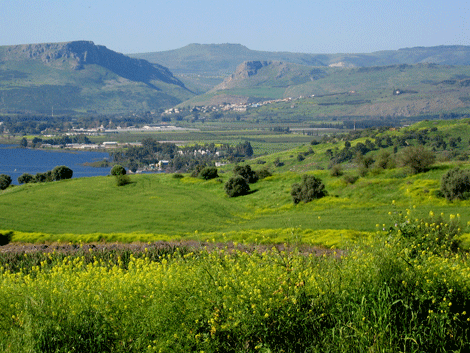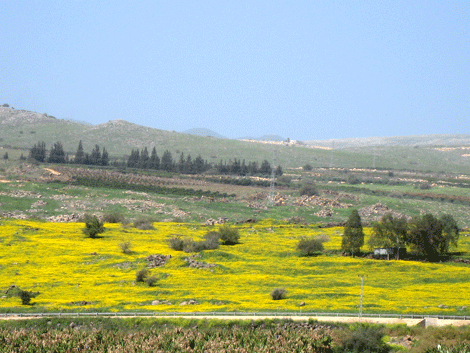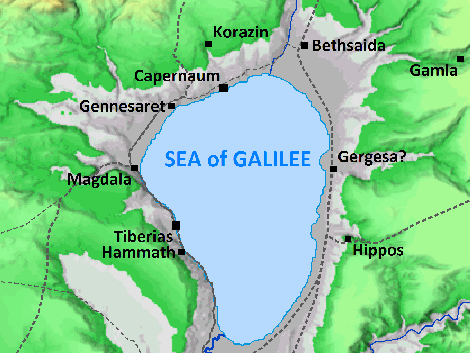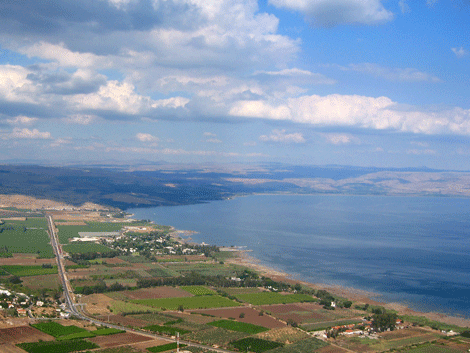|
 |
|
 |
|
Have you ever wondered how the multitudes
managed to hear Jesus' succinct yet vivid
parables -- of the sower, the mustard seed
or the hidden treasure -- as recorded in
Matthew 13 and Mark 4? |
|
|
|
 |
|
Photo:
Gila Yudkin |
|
Fertile Galilee as seen
from the Mount of Beatitudes |
|
|
|
I began pondering this question as I
listened to a gripping account of Abraham
Lincoln's public debates around the US,
right before the 1860 Presidential
convention. The author of "Team of Rivals"
(which I highly recommend!) gave a number of
examples of Lincoln speaking to packed halls
of up to 1500 people. How could he
have done this without a microphone and a
sound system, I wondered? |
|
|
Then I remembered an article I read in the
1980s as a rookie guide which explored
acoustics and crowd capacity of natural holy
land outdoor theaters. I found that I
still had a hand-written summary of the
article which had originally been published
in 1976 in Biblical Archeologist. (It
was of course before the computer age, when
we all sat in libraries to learn and take
notes!)
|
|
 |
|
Photo:
Gila Yudkin |
|
Field with mustard seed as
seen from the Mount of Beatitudes |
|
|
|
Along the shore south of Capernaum, in a
cove with the appearance of a natural amphitheater,
an amateur archeologist and a sound engineer
determined to test the following acoustic
possibility: that when great multitudes
crowded to the shore of the Sea of Galilee
and Jesus withdrew from them in a boat, that
they would be able to hear him distinctly. |
|
|
|
 |
|
Photo:
Gila Yudkin |
|
Shore of the Sea of
Galilee as seen from Capernaum |
|
|
The hypothesis was tested by measuring the
sound of bursting balloons all the way up
the steep slope, at varying distances until
the sound engineer reached the present-day
road, about one hundred yards away. The
archeologist whose task was to burst the
balloons stood on a large rock protruding
from the cove's waters about ten yards from
the center of the arc composing the
shoreline at that time.
The bright-colored balloons attracted the
attention of motorists driving along the
Capernaum-Tiberias road and some even did
"double-takes" at the unexpected sight by
the sea. The spontaneous reactions of
passers-by turned out to be acoustic tests
by themselves.
|
|
|
|
In one example, in a UN car driving north,
the driver turned to his companion and
asked, "What's that guy doing down there?" The companion replied, "I don't know! He's
just standing there and holding some
balloons!" This exchange was heard clearly
by the tester on the rock holding the
balloons, some 100 yards away, even though
he couldn't distinguish the occupants of the
car. |
|
|
|
At the end of the experiment, the sound
engineer concluded that the bowl-like
setting of the cove where Jesus sat in a
boat a short distance away while addressing
a steeply sloped audience would have created
an optimal situation for enhanced speech
communication.
|
|
|
|
When a person's voice is
projected in a line that grazes the
audience's heads, the high frequencies which
distort sound would be absorbed by hair,
clothing and this case, vegetation. And
lower frequencies which also distort sound
would be absorbed by the crowds sitting in a
steeply-raked formation. Thus, they
concluded, Jesus could have been both seen
and heard clearly, by some 5 to 7 thousand
people! This number is certainly compatible
with the Gospels' description of "great
crowds." |
|
|
|
 |
|
Copyright
2012 by Gila Yudkin |
|
Map of major sites around
the Sea of Galilee |
|
|
|
I suggest you come to Galilee and see for
yourself. We will drive by the bowl-shaped
cove and check out the natural amphitheater. We can retell the parable of the sower's
seed, as we take note of Jesus' natural
classroom: the thistles, the black stony
soil and the rich fertile soil. |
|
|
|
 |
|
Photo:
Gila Yudkin |
|
Looking eastwards from the
Mount of Beatitudes |
|
|
|
 |
|
Photo:
Gila Yudkin |
|
Looking over the sites of
Jesus' Galilean ministry from Mount Arbel |
|
|
|
And we will pray that we'll be like those
who received the seed on good ground, who
hear the word and understand it, and
furthermore bear fruit, yielding a hundred,
sixty or thirty times what was sown.
(Matthew 13:23)
|
|
|
|
Copyright 2013, 2014 Gila Yudkin. Permission
needed for any reuse. |
|
|
|
Gila
Yudkin is a Connecticut-born
Yankee guiding in Galilee for over three
decades. Although she has never spoken to
1500 people without a microphone, one of
Gila's last tour hosts told her agency, "Her
voice is clear and she has good volume which
is an asset in a group as elderly as this
one." (Most of the tour members were
in their early to middle seventies.)
|
|
|
|
Abraham Lincoln expressed the wish to his
wife Mary that he would like to visit the
Holy Land when he retired after his second
term as president. Gila sure would
have liked to have been his guide! Two
years after Lincoln's assassination, Mark
Twain joined a holy land pilgrimage and
recounted the foibles of his fellow
travelers in Innocents Abroad. Read
Gila's adaptation of Mark Twain at his
humorous best,
Mark Twain's Tips for Holy
Land Pilgrims. |
|
|
In the Sermon on the Mount, Jesus refers to
a "city on a hill which cannot be hid." One
of the most accepted theories is that Jesus
was referring to the Decapolis city of
Hippos, directly across the Sea of Galilee.
Read about
Hippos.
|
|
|

